How can I get the area under overlapping density curves?
How can I solve the problem with R? (There is a solution for python here: Calculate overlap area of two functions )
set.seed(1234)
df <- data.frame(
sex=factor(rep(c("F", "M"), each=200)),
weight=round(c(rnorm(200, mean=55, sd=5),
rnorm(200, mean=65, sd=5)))
)
ggplot(df, aes(x=weight, color=sex, fill=sex)) +
geom_density(aes(y=..density..), alpha=0.5)
"The points used in the plot are returned by ggplot_build(), so you can access them." So now, I have the points, and I can feed them to approxfun, but my problem is that i don't know how to subtract the density functions.
Any help greatly appreciated! (And I believe in high demand, there is no solution for this readily available.)

